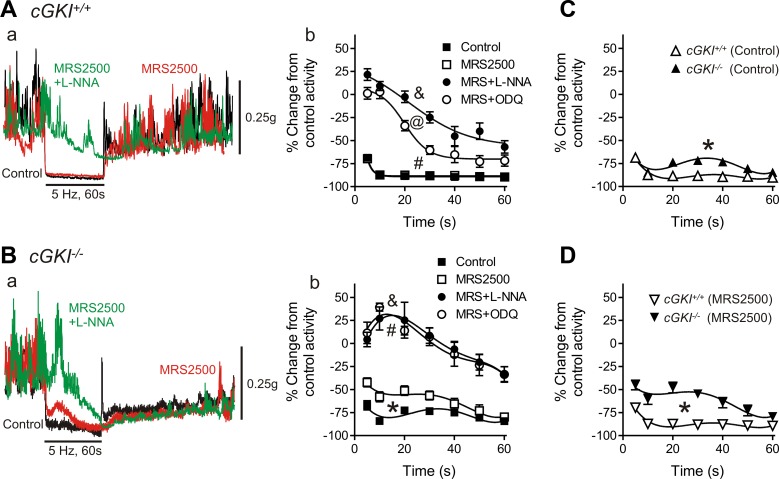Fig. 9.
Comparison of nerve-mediated relaxations in the cGKI+/+ and cGKI−/− IAS. Superimposed contractile traces are shown for responses to nerve stimulation [5 Hz electrical field stimulation (EFS), 60 s] in the cGKI+/+ (Aa) and cGKI−/− (Ba) IAS under control conditions (black) in the presence of MRS2500 (MRS; red) and with MRS2500 plus Nω-nitro-l-arginine (l-NNA; green). Relaxation in the cGKI+/+ IAS was not reduced with MRS2500 alone but was significantly reduced with MRS2500 plus l-NNA (&P < 0.05; Aa, Ab). In the cGKI−/− IAS relaxation was significantly reduced with MRS2500 (*P < 0.05) and further reduced with MRS2500 plus l-NNA (&P < 0.05; Ba, Bb). MRS2500 plus ODQ also reduced relaxation significantly more than MRS2500 alone in both mice (#P < 0.05). The effect of ODQ differed in that it reduced relaxation in combination with MRS2500 to a lesser extent than MRS2500 plus l-NNA in the cGKI+/+ IAS (@P < 0.05), whereas in the cGKI−/− IAS relaxation was reduced to the same extent by either drug combination. C and D: comparison of neural responses in the cGKI+/+ and cGKI−/− IAS. Small but significant differences were observed in neural responses in the cGKI−/− IAS under control conditions (C, *P < 0.05) and in the presence of MRS2500 (D, *P < 0.05); n = 13 cGKI+/+, n = 11 cGKI−/− control; n = 13 cGKI+/+, n = 11 cGKI−/− MRS2500; n = 6 cGKI+/+, n = 4 cGKI−/− MRS2500 plus l-NNA; n = 7 cGKI+/+, n = 5 cGKI−/− MRS2500 plus ODQ.

